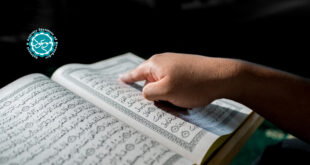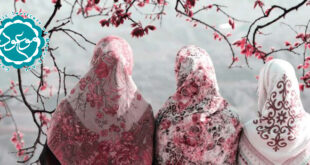Reason Two
Some Hadith do not plainly mention the face and hands although they indirectly denote the fact that covering the face and hands is not obligatory.
Ahmad ibn Muhammad ibn Abinasr said, “I asked Imam Ridha (‘a) if a man can look at the hair of his wife’s sister. He answered, ‘No, unless his wife’s sister is old and decrepit.’ I then said, ‘A wife’s sister and non-mahram women are the same?’ He answered, ‘Yes.’ I said, ‘So what parts of an old woman may I look at?’ He answered, ‘Their hair and arms.’”17
The fact that the narrator of this Hadith asks about the permissibility of looking at the hair of one’s wife’s sister but does not ask about looking at her face shows that he regarded its permissibility certain, or else asking about looking at her face had precedence. Additionally, from the fact that in reply to the question regarding the extent one can look at an old woman, the Imam answered,‘her hair and arms’ and did not add her face, shows that he too regarded the permissibility of looking at a woman’s face an obvious fact that did not need explaining, otherwise, he should have mentioned it.
Ahmad ibn Muhammad ibn Abinasr cited from Imam Ridha, “A boy is made to pray at seven years of age but women cover their hair from him when he starts having involuntary ejaculations of semen during sleep [ihtilam].”18
Abd ur-Rahman ibn al-Hajjaj said, “Regarding a girl who is not yet mature, I asked Imam Musa ibn Ja‘far (‘a), ‘When must she cover her head from non-mahram men and when must she veil her head for salat?’ He answered, ‘She need not cover her head until the age that prayer becomes prohibited for her [due to menstruation].”19
These two Hadith indicate that the necessity of covering one’s head and hair is an effect of physical maturity; however, nothing is said of the necessity of covering the face. If it was truly obligatory, stating this fact would have precedence. Thus, it is demonstrated that covering one’s face is not obligatory for women.
Reason Three
As I have indicated, it can be discerned from the statement لا یُبدِینَ زِینَتَهُنَّ إِلّا ما ظَهَرَ مِنها that covering the hands and face is not obligatory since various Hadith of the Ahl ul-Bayt state that applying Surmah and wearing rings are instances of إِلّا ما ظَهَرَ مِنها and need not be covered. Hence, covering the face and hands, which are the locations of these adornments, must not be necessary.
Moreover, the statement وَلْیَضْرِبْنَ بِخُمُرِهِنَّ عَلیٰ جُیُوبِهِنَّ, which is mentioned in this same verse, also indicates the inessentiality of covering the face because it advises women to cast their veil or headscarf over their necks and breasts and says nothing about covering their face, which shows that it is not necessary. Additionally, in the Hadith from Mas‘adah ibn Sadaqah, which was previously mentioned in this discussion, the face and two hands were enumerated as instances of إِلّا ما ظَهَرَ مِنها.
Reason Four
Various Hadith and historical facts reveal that at the time of the Prophet of Allah (S), it was not traditional for women to cover their face and they would go about in public places with their faces uncovered. Men would see their faces, they would talk to each other, socialize and barter, and women would listen to Hadith from the Prophet (S) and cite them to men.
There are hundreds of female narrators of Hadith, including even the wives and daughters of the Prophet (S). ‘Ayishah, Hafsah, Umm Salamah, and Fatimah (‘a) have cited hundreds of Hadith and this necessitates men seeing women’s faces and hearing their voices. The Prophet of Allah (S) neither commanded women to cover their faces, nor did he forbid men from looking at their faces and hearing their voices, unless it was with sexual and lewd intentions.
Jabir ibn ‘Abdullah Ansari has said: One day the Prophet of Allah (‘a) went to see Fatimah (‘a) while I was with him. When he came to the door of her house, he knocked and declared, ‘as-Salamu ‘Alaykum.’ From within the house, Fatimah (‘a) said, ‘Alayk as-Salam, O Prophet of Allah!’ The Prophet (S) said, ‘May I enter your home?’ Fatimah (‘a) replied, ‘You may.’ The Prophet of Allah (S) said,‘Shall I enter with my companion?’ Fatimah (‘a) replied, ‘O Prophet of Allah! I do not have on my headscarf.’ The Prophet (S) said, ‘Cast the extras of your cloak on your head.’ Fatimah (‘a) did so. Then the Prophet of Allah (S) said,‘as-Salamu ‘Alaykum.’ Fatimah (‘a) replied. Then the Prophet (S) said, ‘Shall I enter with my male companion?’ She answered, ‘Please enter.’
“The Prophet of Allah (S) entered the house and I too entered.
“My eyes came across the face of Fatimah (‘a), which was yellow like turmeric. The Prophet of Allah (S) declared, ‘O daughter! Why is your face yellow so?’ She replied, ‘O Prophet of Allah! It is from intense hunger.’ The Prophet of Allah (S) prayed, ‘O Lord who satiates the hungry, satiate Fatimah daughter of Muhammad!’ I swear by Allah! After the prayer of the Prophet of Allah (S), I looked at the face of Fatimah (‘a). Blood flowed into her face and it became red and after that she no longer felt hungry.20
This narrative shows that Fatimah’s (‘a) face was uncovered in such a way that Jabir first saw its yellowness and after the prayer of the Prophet (S), its redness.
Sa‘d Iskaf cites from Imam Baqir (‘a), “A young man of the Ansar21 encountered a woman in the streets of Madinah. In those times, women would cast their headscarves behind their ears. The Ansari youth stared at her until he came to her and passed her, and then he looked at her from behind. Suddenly, his head hit piece of sharp bone or glass that was sticking out of the wall. His face was cut and blood flowed upon his chest and clothes. The youth said, ‘I swear to God! I shall complain about this woman before the Prophet of Allah (S).’
The youth came into the presence of the Prophet of Allah (S). The Prophet asked,‘Why are you thus bloody?’ The youth recounted the tale. Just then, Gabriel came upon the Prophet (S) and revealed unto him verse 30 of Surah Nur (This verse and its subsequent verse were explicated in detail at the beginning of this chapter).
This account shows that at the time of the Prophet (S) and the advent of Islam, not only did women leave their faces uncovered, they also cast their headscarves behind their ears. Consequently, their ears, earrings, necks, and breasts were apparent. The affair of this Ansari youth took place in this period, which was when he took his complaint to the Prophet (S) and the verse of Hijab was revealed unto the Prophet (S).
This verse advises women to cast the fringes of their headscarves around their necks so that their ears, earrings, necks, and breasts are covered. However, interestingly, no instruction was given regarding covering the face and this demonstrates its inessentiality. In order to prevent ethical and social corruption and the recurrence of incidents similar to the affair of the Ansari youth, the verse of Hijab counsels men and women to cut off their stares and shun leering and lecherousness.

 Mouood Mouood English Edition
Mouood Mouood English Edition



